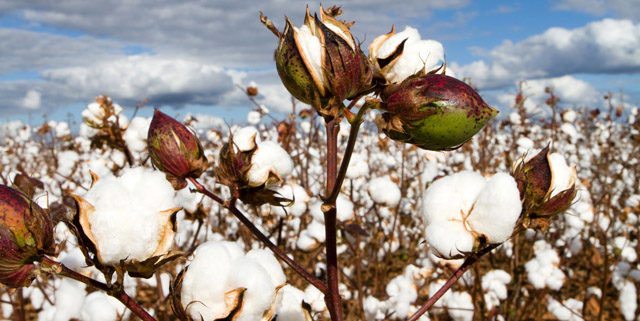RECENT PRICE MOVEMENT
Most benchmark prices decreased over the past month. Chinese prices were stable.
- After moving lower in early August, values for the December NY futures contract have been range-bound, generally trading between 81 and 84 cents/lb.
- The A Index followed a pattern similar to NY futures, with values dropping from levels near 98 cents/lb in early August to those between 91 and 94 cents/lb.
- In dollar terms, the Chinese Cotton Index (CC Index 3128B) was unchanged over the past month, holding to levels near 108 cents/lb. In domestic terms, the CC Index was also stable, holding to levels near 16,300 RMB/ton.
- Indian spot prices (Shankar-6 quality) decreased in local terms, falling from values above 48,000 INR/candy in mid-August those near 47,600 INR/candy. The INR reached record lows against the dollar recently, and the weakening of the rupee helped pull the value of Indian cotton lower in dollar terms. In early August, Indian prices were near 90 cents/lb. The latest values are near 84 cents/lb
- Movement in Pakistani spot prices mirrored that in NY futures, dropping in early August and holding steady in later trading. In dollar terms, Pakistani prices decreased from 88 cents/lb to 80 cents/lb. In domestic terms, prices fell from 9,000 PKR/maund to 8,300 PKR/maund.
SUPPLY, DEMAND, & TRADE
This month’s USDA report featured a meaningful increase to world production (+1.4 million bales, from 120.5 to 122.0 million) and a marginal addition to world mill-use (+0.3 million bales, from 127.6 to 127.9 million). Upward revisions to consumption figures for India over the past couple crop years drove the global estimate for 2018/19 beginning stocks lower (-0.7 million bales, from 84.5 to 83.8). This decrease in beginning stocks, along with the uptick in mill-use, partially offset the effect of a larger harvest forecast on projected world ending stocks.
Relative to last month, the current figure for global ending stocks is 0.4 million bales higher (from 77.1 to 77.5 million). The forecast for stocks for the world-less-China decreased 0.9 million bales, from 48.5 to 47.6 million. Nonetheless, if realized, this volume would still be highest ever for the collection of countries outside China.
The largest country-level revisions for production included those for China (+1.0 million bales, from 26.5 to 27.5 million), Brazil (+500,000, from 9.5 to a record 10.0 million), and the U.S. (+447,000, from 19.2 to 19.7 million). Due to dry conditions, the Australian forecast was lowered 600,000 bales (from 3.6 to 3.0 million).
For mill-use, the only country-level revisions that exceeded 100,000 bales were for India. The USDA lifted its projection for 2018/19 Indian mill-use by 300,000 bales (from 25.2 to 25.5 million). Estimates for Indian consumption in 2016/17 (+350,000, to 24.4 million) and 2017/18 (+500,000, to 24.7 million) were also increased.
Global trade estimates were unchanged at 41.8 million bales. However, there were notable country-level revisions for exports (no country-level revisions over 100,000 bales for 2018/19 imports). These included changes for the U.S. (+200,000 bales, from 15.5 to 15.7 million), Brazil (+200,000, from 5.3 to 5.5 million), India (-100,000, from 4.5 to 4.4 million), and Australia (-400,000, from 4.3 to 3.9 million).
PRICE OUTLOOK
The U.S. cotton belt is facing the second major weather system this month. Tropical storm Gordon mainly passed through the Mid-South growing region (states along the Mississippi River) last week, bringing strong rains and wind. Preliminary reports suggest that not much production was lost. Sunnier weather has since moved into the area and has helped wet fields dry out. Despite the storm, the USDA increased production forecasts for each state in the Mid-South except Missouri.
Hurricane Florence is a much stronger storm and promises to inflict damage on cotton production along the east coast. A first step in analyzing the potential impact is to look at how much acreage is in the states in the storm’s path. According to the USDA’s September estimates, North Carolina, South Carolina, and Virginia (states in the projected path) collectively account for 6% of U.S. planted acres and are expected to represent 8% of national production. Another factor relevant to the development of damage estimates is the stage of crop development. Plants with bolls open, and therefore with fiber exposed, are more vulnerable (bolls can be more easily knocked to the ground and fiber can be stained by moisture). In the Carolinas and Virginia, less than half of acres had bolls open in the USDA’s latest Progress Report (data through September 9th). Given the strength of hurricane Florence, localized impacts on specific fields could be severe. However, with a small proportion of U.S. acres in the storm’s expected path and only a fraction of those acres with bolls open, the national and international implications of the hurricane should be limited.
Of greater concern for cotton price direction is the trade outlook. The central question for trade remains when China might increase imports. The supply-related scare that sent prices higher in May-June suggested that the timeframe may be closer than was previously believed. However, the combination of higher than expected yields out of Xinjiang province (which were the cause of this month’s increase to the production forecast for China) and widespread reports of high levels of inventory held by Chinese mills suggest less immediacy.
